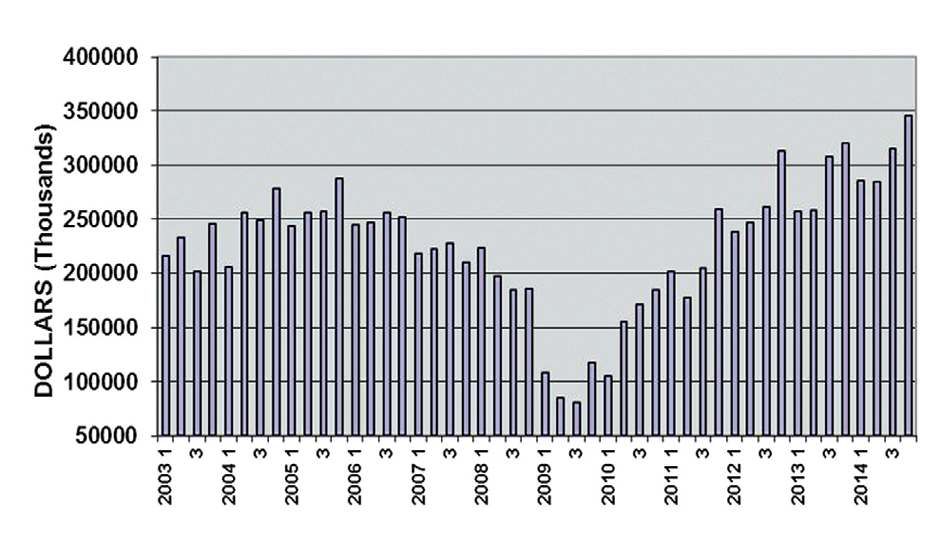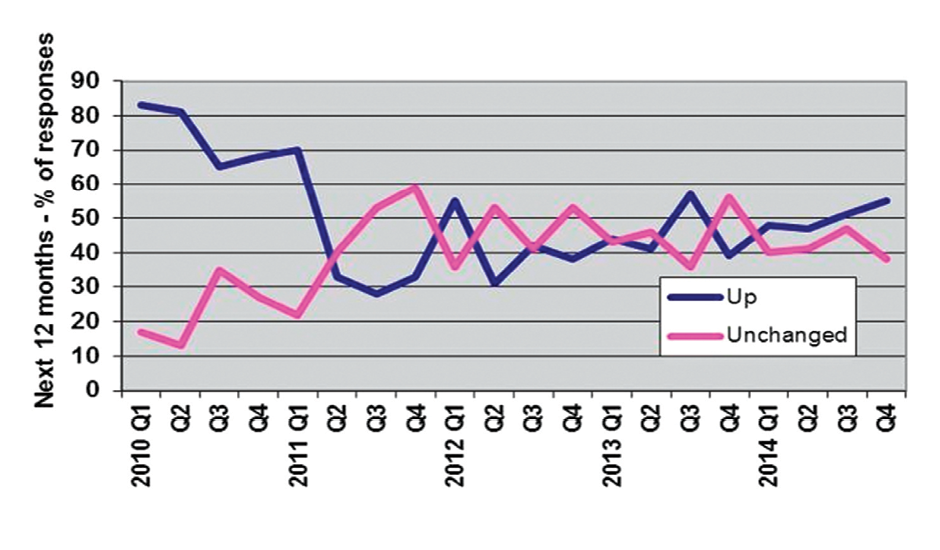Plastics Machinery Shipments Escalated Sharply in Q4
Previous Article Next Article
Plastics Machinery Shipments Escalated Sharply in Q4
Previous Article Next Article
Plastics Machinery Shipments Escalated Sharply in Q4
Previous Article Next Article

Figure 1: Primary plastics equipment shipments, 2003-2014.

Figure 1: Primary plastics equipment shipments, 2003-2014.

Figure 2: Optimism very high for the coming year: 55% expect gains and 39% holding steady.

Figure 2: Optimism very high for the coming year: 55% expect gains and 39% holding steady.
Shipments of plastics machinery posted a robust rise in the fourth quarter of 2014, according to statistics compiled and reported by SPI: the Plastics Industry Trade Association’s Committee on Equipment Statistics (CES).
“Annual shipments of plastics machinery increased for the fifth straight year in 2014, and the economic fundamentals that favor continued investment in capital equipment are expected to persist through 2015 as well,” according to Bill Wood, the plastics market economist who analyzes and reports on the plastics machinery market sector for the CES.
Shipments of primary plastics equipment (injection molding, extrusion, and blow molding equipment) for reporting companies totaled $346.1 million in Q4. This was 9.8% higher than the revised shipments total of $315.1 million in Q3 of this year, and it was up a solid 8.0% when compared with the total from Q4 of 2013. For 2014 as a whole, the total value of primary equipment shipments was up 7.6% compared with the annual total from 2013 (Figure 1).
A closer look at the CES data shows that the shipments value of injection molding machinery advanced 7.7% in Q4 of 2014 when compared with the total from Q4 of 2013. For 2014 as a whole, shipments of injection molding machinery were up 5.3% when compared with the annual total from 2013. And the shipments value of single-screw extruders increased 1.1% in Q4 when compared with last year. For 2014 as a whole, single-screw extruder shipments were down 3.0%.
The value of shipments of twin-screw extruders (which includes both co-rotating and counter-rotating machines) climbed 8.2% in Q4. For 2014 as a whole, shipments of twin-screw extruders jumped 26.3%. The shipments value of blow molding machines advanced 10.2% in Q4, and for 2014 as a whole, the value spiked up a sparkling 38.1%.
The CES also compiles data on the auxiliary equipment segment (robotics, temperature control, materials handling, etc.) of the plastics machinery industry. New bookings of auxiliary equipment for reporting companies totaled $103.5 million dollars in Q4. This represented a gain of 2.2% when compared with the total from Q4 of 2013. For 2014 as a whole, bookings of auxiliary equipment were up 9.2%.
The trend upward in the CES data on plastics machinery shipments corresponds with the long-term trends in the two major data series compiled by the U.S. government that measure overall demand for industrial machinery. According to the Bureau of Economic Analysis, business investment in industrial equipment escalated by 16% (seasonally adjusted, annualized rate) in Q4 when compared with Q4 of 2013, and the annual total for investment in 2014 was up a vigorous 13%.
The other important machinery market indicator compiled by the Census Bureau showed that the total value of new orders of industrial machinery jumped 20% in Q4 when compared with the total from Q4 of 2013, and for the year as a whole in 2014, industrial machinery orders were up a stellar 30%.
“The short-term problems caused by a stronger dollar and a downsized oil patch notwithstanding, the recovery in the U.S. economy will continue through 2015,” said Wood. “The stock market is still at an all-time high. Corporate profits are still at record levels. And as I have said before, the three main trends that will drive the economy over the coming months are already well-established. They are low interest rates, low energy prices, and rising wages and household incomes resulting from stronger employment levels.”
The CES also conducts a quarterly survey of plastics machinery suppliers that asks about present market conditions and expectations for the future. The responses from the Q4 survey indicate that machinery suppliers remain optimistic about the market demand for their products in the coming months. When asked about expectations for future market conditions, 92% of the respondents expect conditions to stay the same or even improve in the coming quarter, and 94% expect them to hold steady or get better during the next 12 months (Figure 2).
There was a strong consensus that North America is the global region where the most promising market conditions for machinery suppliers are expected in the coming year. Expectations for Mexico were also quite high. Expectations for Latin America call for mostly steady market conditions, and this is a bit of an improvement from the last quarter. Expectations for Asia and Europe, which were mostly unchanged from Q3, call for demand to hold steady.
As for the major end-markets, the respondents to the Q4 survey still expect that automotive and medical will remain strong in terms of demand for plastics products and equipment. Expectations for all other end-markets call for steady-to-better demand to prevail in 2015.
